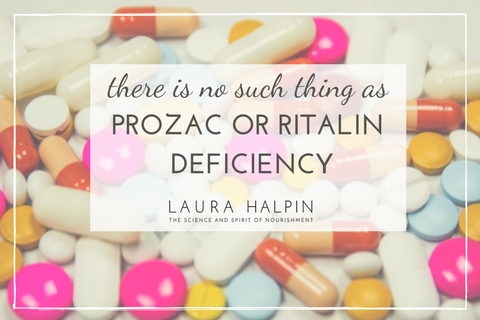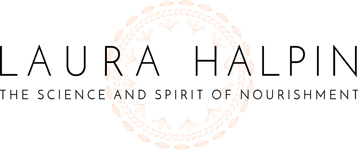
There’s no such thing as a Prozac or Ritalin deficiency!
Hello my friends,
Recently, I attended the annual conference of the National Association of Nutrition Professionals. One of the seminars was “Advanced Nutrient Therapy to Heal Brain Imbalances” presented by internationally recognized expert, William Walsh, PhD. He has had a lengthy, awe-inspiring career (and he’s not done yet). A chemical engineer by training, Dr. Walsh was employed by Argonne National Laboratory in the 70s. He also spent years volunteering in an Illinois state prison, developing educational and art programs for inmates. His professional and volunteer work merged when he became increasingly interested in the science behind violent behavior.
He started testing the brain chemistry of the most violent criminals through blood and urine samples, eventually becoming an expert in his field. He’s been called upon to test the blood and urine of many mass murderers, including Charles Manson and Richard Speck. Ick.
Eventually this work led to the study of violent children, again testing the biochemistry of troubled kids and comparing their chemistries to those of their non-violent siblings. What Dr. Walsh found was that violent children had similar nutrient imbalances and similar heavy metal toxicity patterns (such as mercury, cadmium and lead poisoning) as death row inmates. These kids weren’t bad seeds; they had imbalances that could be remedied.
He also found that the nutrient deficiencies and toxic loads of violent children and violent adults fell into two main patterns that lead to differences in frequency of violence, degrees of remorse, and other differences in behavior and personality.
Dr. Walsh found remarkable success when he began to treat his subjects with targeted nutrients and supplements. In the vast majority of cases, violent episodes in children disappeared or were significantly curtailed.
From there, his testing expanded to people with mental illnesses (such as depression and schizophrenia) and other cognitive disorders (such as learning disabilities, autism, Alzheimer’s, and ADHD). Again, he found very distinctive patterns of nutrient deficiencies and toxicity. He also found that terms like depression and schizophrenia and ADHD are umbrella terms under which there are distinct “bio-types.” For example, two depressed people could have widely different brain chemistries and symptoms. He has identified five main depressive root cause patterns. Without the insights that simple and inexpensive testing can give, doctors are left to prescribe medications that may or may not address the heart(s) of the matter.
In his book Nutrient Power: Heal Your Biochemistry and Heal Your Brain,” Dr. Walsh writes, “Today’s emphasis on prescription psychiatric medications will not stand the test of time” and the benefits of this approach “are partial in nature and involve unpleasant side effects.”
Ultimately, Dr. Walsh developed the world’s largest database of blood and urine samples of individuals suffering from mental and behavioral disturbances. He has developed treatment protocols for these patients based on their biochemistry. These protocols include nutrients with no side effects. At times, medications are still used, but the dosages are drastically reduced. Dr. Walsh’s practices are now being adopted by practitioners all over the world. This is medicine at its best.
Brain Chemistry 101
Most of us understand that when someone is diagnosed with depression, ADHD, or autism, for example, that there is a brain chemistry issue at hand. Yet our understanding needs to expand from there. Brain chemistry does not exist in a vacuum, nor is it stagnant or impervious to input. If it were, we wouldn’t be using meds like Prozac and Ritalin to change our chemistries.
We feel energetic, focused, optimistic, confident, calm — or anxious, depressed, pessimistic and scattered — depending on our body’s ability to produce neurotransmitters and have them taken up by neurons in adequate amounts. Yet, we must ingest the raw materials needed (protein) to make neurotransmitters. We also need certain nutrients and enzymes to break down dietary proteins into amino acids and convert them into neurotransmitters such as serotonin, dopamine, melatonin, and others. For example, one nutrient necessary to convert the amino acid tryptophan into serotonin is B6.
Sometimes, even if we are ingesting sufficient protein and vitamins, there is an absorption issue. We might have GERD or acid reflux — which is most often caused by a lack of stomach acid, not too much — and take an acid pump inhibitor. Yet we need stomach acid to break down our protein, and to absorb nutrients like iron and B12. Taking care of gut health may seem like an arbitrary approach to easing anxiety or depression, but gut health is a major factor.
Some people have a decreased ability to rid their bodies of the thousands of chemicals we are exposed to and this toxicity can severely impact one’s brain health. Just ask Dr. Walsh who found lead and mercury poisoning to be a common factor in mass murderers. Yikes. Therefore, tending to our liver health needs to be part of the protocol.
 It may sound complicated. Looking at one’s body holistically certainly isn’t a linear process. Our bodies are elegant, complex, intelligent ecosystems that can be thrown off if we take a synthetic medication to deal with health issues at the symptom level. Have you read the list of side effects of Ritalin?
It may sound complicated. Looking at one’s body holistically certainly isn’t a linear process. Our bodies are elegant, complex, intelligent ecosystems that can be thrown off if we take a synthetic medication to deal with health issues at the symptom level. Have you read the list of side effects of Ritalin?
If we struggle with anxiety, depression, ADHD, bipolar disorder, schizophrenia, medication might help relieve our symptoms, but it won’t fully heal us. Unfortunately, despite the fact that none of us is suffering from a Prozac deficiency, one out of four women in the U.S. is taking some kind of anti-anxiety/depression medication. This is not to say that a medication is never warranted. Not at all.
There’s Help to be Had
This is the brilliance of Dr. Walsh’s work and the work of functional doctors who are willing to look under the hood, rather than pull out the prescription pad at the first mention of sadness or inability to cope or concentrate.
Holistic nutritionists like me can help people wade through the first rounds of brain balancing. For example, balancing blood sugar, addressing fatty acid imbalances, eliminating food additives, identifying food sensitivities, and addressing gut and liver health through food are all angles to pursue. All this can make an enormous difference in whether a kid can sit still in his seat and focus, and whether you feel like getting out of bed in the morning.
 I have to say I love what I do. In my last workshop, one of my newest clients — after a lifetime of acute suffering — shared she’s never felt better in her life. What did she do? She started cooking at home and eliminated dairy from her diet. Another client who never feels good and has suffered from multiple autoimmune diseases felt better within a day of eliminating gluten. Another client no longer experiences seasonal allergies after taking out gluten and cleansing her liver (and she was a Claritin-a-day kind of girl).
I have to say I love what I do. In my last workshop, one of my newest clients — after a lifetime of acute suffering — shared she’s never felt better in her life. What did she do? She started cooking at home and eliminated dairy from her diet. Another client who never feels good and has suffered from multiple autoimmune diseases felt better within a day of eliminating gluten. Another client no longer experiences seasonal allergies after taking out gluten and cleansing her liver (and she was a Claritin-a-day kind of girl).
Chronic conditions — no matter if it’s depression, an auto-immune disorder, IBS, arthritis, allergies, eczema, ADHD — are signs that the body is out of balance. Join me in the coming months to learn how to bring your body, or the body of someone you love, back into balance in safe and non-intrusive ways. It’s all about giving the body what it needs so it can operate according to its elegant and innate brilliance.
Warmly,
Laura Halpin
Join me for any or all of Growing Health’s upcoming offerings:
Mindful Mondays
The Skinny on Fats – Monday, May 13, 7-9 p.m.
Nutrition and Anxiety – Monday, June 3, 10-12 noon
Multi Session Workshops
Teen Nutrition: Feeding the Mind, the Mood and the Skin – July 2013
Revitalizing Cleanse – September/October 2013
Free Events
Women and Sleep – May 21, 2013




